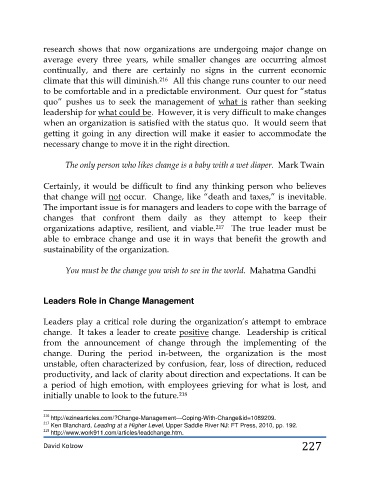Page 227 - 4- Leading_from_Within
P. 227
research shows that now organizations are undergoing major change on
average every three years, while smaller changes are occurring almost
continually, and there are certainly no signs in the current economic
climate that this will diminish. 216 All this change runs counter to our need
to be comfortable and in a predictable environment. Our quest for “status
quo” pushes us to seek the management of what is rather than seeking
leadership for what could be. However, it is very difficult to make changes
when an organization is satisfied with the status quo. It would seem that
getting it going in any direction will make it easier to accommodate the
necessary change to move it in the right direction.
The only person who likes change is a baby with a wet diaper. Mark Twain
Certainly, it would be difficult to find any thinking person who believes
that change will not occur. Change, like “death and taxes,” is inevitable.
The important issue is for managers and leaders to cope with the barrage of
changes that confront them daily as they attempt to keep their
organizations adaptive, resilient, and viable. The true leader must be
217
able to embrace change and use it in ways that benefit the growth and
sustainability of the organization.
You must be the change you wish to see in the world. Mahatma Gandhi
Leaders Role in Change Management
Leaders play a critical role during the organization’s attempt to embrace
change. It takes a leader to create positive change. Leadership is critical
from the announcement of change through the implementing of the
change. During the period in-between, the organization is the most
unstable, often characterized by confusion, fear, loss of direction, reduced
productivity, and lack of clarity about direction and expectations. It can be
a period of high emotion, with employees grieving for what is lost, and
initially unable to look to the future.
218
216 http://ezinearticles.com/?Change-Management---Coping-With-Change&id=1089209.
217
Ken Blanchard, Leading at a Higher Level, Upper Saddle River NJ: FT Press, 2010, pp. 192.
218
http://www.work911.com/articles/leadchange.htm.
David Kolzow 227

